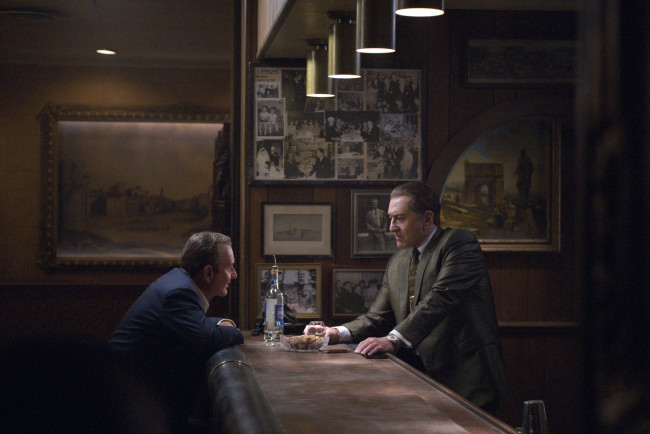MOVIE REVIEW: ‘The Irishman’ paints Scorsese mob film legacy with mature brush

Before an advance screening of “The Irishman” began last Monday at R/C Movies 14 in Wilkes-Barre, filmmaker Robert May stood in the same theater where his directorial debut, “Kids for Cash,” premiered locally and told the crowd that he felt it was important to have a local screening in addition to those planned at the Dietrich Theater in Tunkhannock this week, so they worked with Netflix and Allied Global Marketing to make it happen.
While May’s film is much more focused on his native Luzerne County, the local connections to the real-life story of “The Irishman” can’t be denied. In the first few minutes of the film, hitman Frank Sheeran picks up mob boss Russell Bufalino at his home in Kingston. Later, he pulls out a map and the Scranton/Wilkes-Barre area is prominently circled. Bufalino is seen operating part of his criminal enterprise out of Penn Drape & Curtain Company in Pittston, and that’s pretty much all of the direct mentions of Northeastern Pennsylvania on screen, though some scenes may also take place in the area but aren’t specifically named.
The movie is based on the bestselling true crime book “I Heard You Paint Houses” by Charles Brandt, and the opening even reads “I Heard You Paint Houses” rather than the generic marketing title of “The Irishman.” Brandt has visited NEPA to promote it a few times, most recently in March at the Northeast Pennsylvania Film Festival in Scranton. During that sold-out talk, he discussed meeting with iconic director Martin Scorsese, star Robert De Niro (who plays Frank Sheeran), and Academy Award-winning screenwriter Steven Zaillian and how it was like “winning the lottery.”
“I sat there with these men as part of a very important and historic project. It was awe-inspiring and humbling. They’re such geniuses and I don’t know their craft, but I know that the questions they asked me about the people involved showed a sensitivity and humanity that I was in awe of,” he explained.
Brandt’s comments about “sensitivity and humanity” ring true when watching the film, which tells the story of how Sheeran went from a Philadelphia truck driver to a killer for the Bufalino crime family who befriended and allegedly murdered labor union leader Jimmy Hoffa, played by Al Pacino. For most of Hollywood, the temptation with this type of epic that follows larger-than-life criminals across decades would be to play everything even bigger – massive shootouts in slow motion, dramatic speeches about morality, emotional screaming matches, and poignant dying words. Thankfully, Scorsese and company are much more interested in telling a grounded story with the kind of nuance one would expect from legends now in their 70s.
While this reunites De Niro, Joe Pesci, and Scorsese decades after they made “Goodfellas” and “Casino,” don’t expect any “Funny how?” moments, as entertaining and quotable as they are. For much of its three-and-a-half-hour runtime, the characters undergo subtle but steady development, and important scenes are delivered through subtle expressions and quiet moments. Pesci is particularly known for his loud and flashy characters, but he comes out of retirement to portray Bufalino, “The Quiet Don,” here, so his restraint is his greatest strength in the role, managing to be as intimidating as ever without even raising his voice.
De Niro is portraying a man who kills for money, but Sheeran isn’t some slick badass – he stutters, especially when he’s nervous, and he can’t seem to bring himself to just talk to his daughters and build any kind of meaningful relationship with them. His background as a soldier who coldly commits war crimes also says a lot with such a brief scene, and his hits are carried out and filmed matter-of-factly, quick and emotionless. The sudden shots of his gun made a few people in the theater jump as the near-silence on screen was shattered, much like a real shooting in the street would. Victims aren’t reaching up in the air and delivering final speeches, and the deaths aren’t dignified or glorified, particularly Hoffa’s.
It’s not really a spoiler to mention that Hoffa dies, as his mysterious disappearance in 1975 is arguably what he’s most famous for these days, so it’s interesting to go back to a time when he was best known as the charismatic president of the International Brotherhood of Teamsters and working class hero despite his mafia connections. Pacino adopts more than an accent here and, much like De Niro, he is able to make you feel a bit sorry for someone who deserves little sympathy as his crimes pile up. Watching those who make it out alive age and then deal with the sad and lonely consequences of their actions later in life truly ground this true crime story, disputed “facts” and all.
Even on a big screen, the de-aging technology that ballooned the movie’s budget is impressive and continues to trick the eye (except for maybe the shopkeeper scene) as Scorsese jumps back and forth in time, a structure that makes more sense as the story reaches its inevitable conclusion. The runtime may seem excessive, but it moves at a brisk enough pace that it doesn’t feel like a slog, and since most people will be watching it on Netflix, where it landed today, it’s easy to pause and come back to. A bit more trimming could have been done without too much lost, though why not take advantage of this modern streaming format and spend some extra time with these fascinating people played by some of the best actors of our time?
Cynics may see “The Irishman” as a way for these guys to repeat the successful gangster movies they’ve made before, but this isn’t a rehash or a reboot – it’s a rare case of actors and filmmakers in 2019 with something a bit different to say as they get older, a perspective that benefits from the experience of creating so many classics. In an age dominated by franchises and remakes, we should all be thankful for a deeper moviegoing (or, rather, movie lounging) experience like this, just in time for Thanksgiving.
Watch NEPA Scene’s exclusive video of Brandt’s Northeast Pennsylvania Film Festival presentation, “When Scorsese Calls,” below:
by Rich Howells
Rich is an award-winning journalist, longtime blogger, photographer, and podcast host. He is the founder and editor of NEPA Scene.





